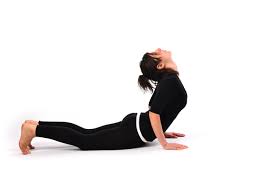be warm
As autumn settles in, here in New Zealand, it is a good time to reassess your yoga practice, and for teachers to modify their classes, to accommodate the cold.
Our bodies move easier when we are warm, so:
Any variation of sun salutes is good. At home, just a few will suffice. They are incredibly warming, if they are done at a brisk pace. So are the wide legged standing poses, such as warriors, triangle, and forward bend. If you do these, either skip the squats or do just a few squats.





a little warming and loosening sequence
A nice example of warming dynamic poses, is:
1. mountain (down dog), swinging through to cobra with toes tucked under and knees off floor; done several times.

 transition pose
transition pose

2. An easier, but equally effective routine would be three to five repetitions of the following, starting from child or all fours. And done after standing poses:
more warming asanas
Back rolls especially plough to forward bend are very warming, and can be done as a transition from standing to lying on your back. And back bends are warming too. Generally you would do more back bends in the morning. I was always taught that back bends are too stimulating to do at night, but as an asthmatic, I have found that an evening back bend opens up the lungs, making it easier to sleep. If you are someone who gets anxious, the softer poses like child pose will be better for you.
winter warming breath
Pranayama, the yoga breathing techniques, can be many things:
Obviously, in colder weather, pranayama for warmth is recommended. The absolute best warming pranayama is bhastrika. Bhastrika is rapid breathing in and out of the nostrils, at the rate of one to two per second.:
The best pranayama to accompany bhastrika is the alternate nostril breath.
As autumn settles in, here in New Zealand, it is a good time to reassess your yoga practice, and for teachers to modify their classes, to accommodate the cold.
Our bodies move easier when we are warm, so:
- practising or teaching in a warm room is preferred
- and so is adding some dynamic warm-ups. Dynamic just means "moving"
- dynamic standing twists, hip rotations, shoulder joint rotations using the whole arm, squats, are all useful to start your session.
- so is taking your arms up the front of the body, to overhead, as you arch backwards. Then, sweep the arms forwards as you go into a forward bend, with knees a bit bent.
- Do 5 - 10 times of all of these movements to warm up and loosen.
Any variation of sun salutes is good. At home, just a few will suffice. They are incredibly warming, if they are done at a brisk pace. So are the wide legged standing poses, such as warriors, triangle, and forward bend. If you do these, either skip the squats or do just a few squats.

a little warming and loosening sequence
A nice example of warming dynamic poses, is:
1. mountain (down dog), swinging through to cobra with toes tucked under and knees off floor; done several times.
- You can start as for sun salute, and step back into mountain, go to cobra, do this three to five times, finishing with mountain, jump or step forward to forward bend, then stretch up and back, then to prayer. This makes it like a salute.
- Or, even build up to it: start as for sun salute, go to mountain, then all-fours for three to five repetitions of cat pose, then back to mountain, and finish as for sun salute.
- The next version could be moving into all-fours then child, from mountain. Then slink forwards into cobra, go into mountain, all-fours, child, three to five times. After the last mountain, come forwards as previous.
- You could even do mountain, all-fours, then repeat child-cobra-child three to five times, then mountain, then return to start. You could do this before the previous version.
- If you do three times for each version, going from easy to hard, you will have an excellent series to teach, or to do at home.
2. An easier, but equally effective routine would be three to five repetitions of the following, starting from child or all fours. And done after standing poses:
- cat; child-cobra-child
- child-cobra-mountain-all fours-child
- mountain-cobra with toes tucked under-mountain
- You could rest in child between each variation, with the option of resting in mountain instead.
more warming asanas
Back rolls especially plough to forward bend are very warming, and can be done as a transition from standing to lying on your back. And back bends are warming too. Generally you would do more back bends in the morning. I was always taught that back bends are too stimulating to do at night, but as an asthmatic, I have found that an evening back bend opens up the lungs, making it easier to sleep. If you are someone who gets anxious, the softer poses like child pose will be better for you.
winter warming breath
Pranayama, the yoga breathing techniques, can be many things:
- cooling,
- warming
- calming
- stimulating
- balancing.
Obviously, in colder weather, pranayama for warmth is recommended. The absolute best warming pranayama is bhastrika. Bhastrika is rapid breathing in and out of the nostrils, at the rate of one to two per second.:
- start with five bhastrikas
- then when you are used to doing them, add another set of five
- when you can do four sets of five bhastrikas, move into two sets of ten.
- the next step is to do twenty without stopping
- now, gradually increase moving up to one round of one hundred and twenty bhastrikas.
The best pranayama to accompany bhastrika is the alternate nostril breath.
Comments
Post a Comment
You can leave comments here - comments are moderated for the time being.